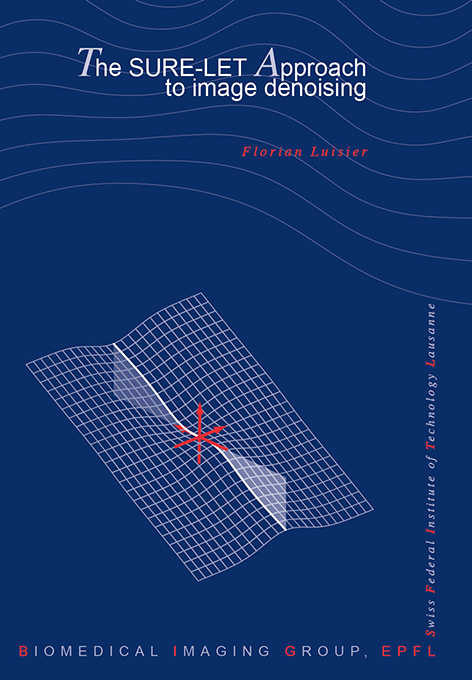The SURE-LET Approach to Image Denoising
F. Luisier
École polytechnique fédérale de Lausanne, EPFL Thesis no. 4566 (2010), 232 p., January 8, 2010.
Denoising is an essential step prior to any higher-level image-processing tasks such as segmentation or object tracking, because the undesirable corruption by noise is inherent to any physical acquisition device. When the measurements are performed by photosensors, one usually distinguish between two main regimes: in the first scenario, the measured intensities are sufficiently high and the noise is assumed to be signal-independent. In the second scenario, only few photons are detected, which leads to a strong signal-dependent degradation. When the noise is considered as signal-independent, it is often modeled as an additive independent (typically Gaussian) random variable, whereas, otherwise, the measurements are commonly assumed to follow independent Poisson laws, whose underlying intensities are the unknown noise-free measures.
We first consider the reduction of additive white Gaussian noise (AWGN). Contrary to most existing denoising algorithms, our approach does not require an explicit prior statistical modeling of the unknown data. Our driving principle is the minimization of a purely data-adaptive unbiased estimate of the mean-squared error (MSE) between the processed and the noise-free data. In the AWGN case, such a MSE estimate was first proposed by Stein, and is known as "Stein's unbiased risk estimate" (SURE). We further develop the original SURE theory and propose a general methodology for fast and efficient multidimensional image denoising, which we call the SURE-LET approach. While SURE allows the quantitative monitoring of the denoising quality, the flexibility and the low computational complexity of our approach are ensured by a linear parameterization of the denoising process, expressed as a linear expansion of thresholds (LET). We propose several pointwise, multivariate, and multichannel thresholding functions applied to arbitrary (in particular, redundant) linear transformations of the input data, with a special focus on multiscale signal representations.
We then transpose the SURE-LET approach to the estimation of Poisson intensities degraded by AWGN. The signal-dependent specificity of the Poisson statistics leads to the derivation of a new unbiased MSE estimate that we call "Poisson's unbiased risk estimate" (PURE) and requires more adaptive transform-domain thresholding rules. In a general PURE-LET framework, we first devise a fast interscale thresholding method restricted to the use of the (unnormalized) Haar wavelet transform. We then lift this restriction and show how the PURE-LET strategy can be used to design and optimize a wide class of nonlinear processing applied in an arbitrary (in particular, redundant) transform domain.
We finally apply some of the proposed denoising algorithms to real multidimensional fluorescence microscopy images. Such in vivo imaging modality often operates under low-illumination conditions and short exposure time; consequently, the random fluctuations of the measured fluorophore radiations are well described by a Poisson process degraded (or not) by AWGN. We validate experimentally this statistical measurement model, and we assess the performance of the PURE-LET algorithms in comparison with some state-of-the-art denoising methods. Our solution turns out to be very competitive both qualitatively and computationally, allowing for a fast and efficient denoising of the huge volumes of data that are nowadays routinely produced in biomedical imaging.

@PHDTHESIS(http://bigwww.epfl.ch/publications/luisier1001.html,
AUTHOR="Luisier, F.",
TITLE="The {SURE-LET} Approach to Image Denoising",
SCHOOL="{\'{E}}cole polytechnique f{\'{e}}d{\'{e}}rale de {L}ausanne
({EPFL})",
YEAR="2010",
type="{EPFL} Thesis no.\ 4566 (2010), 232 p.",
address="",
month="January 8,",
note="")